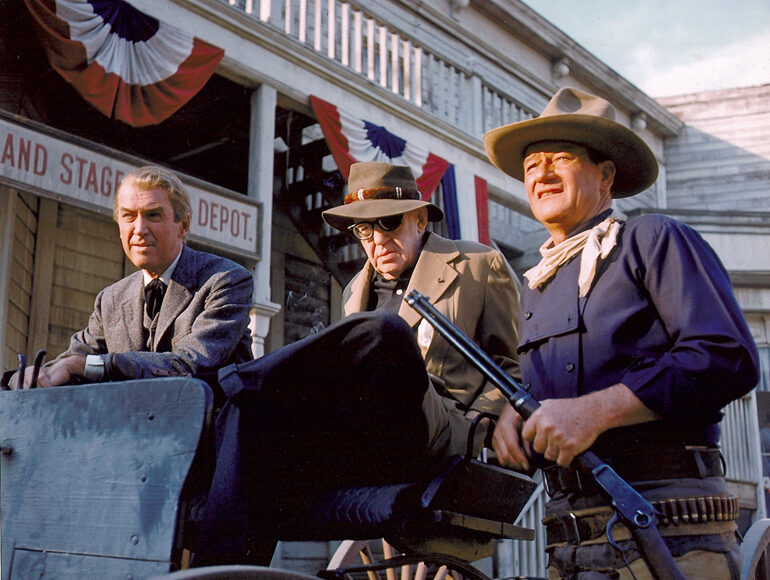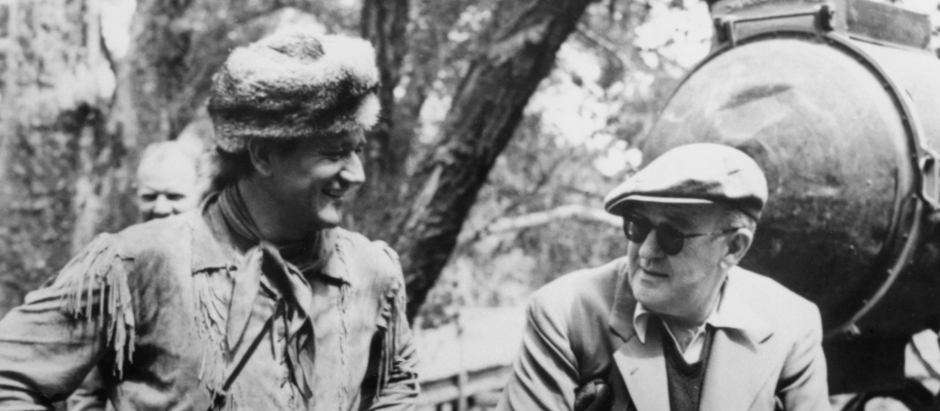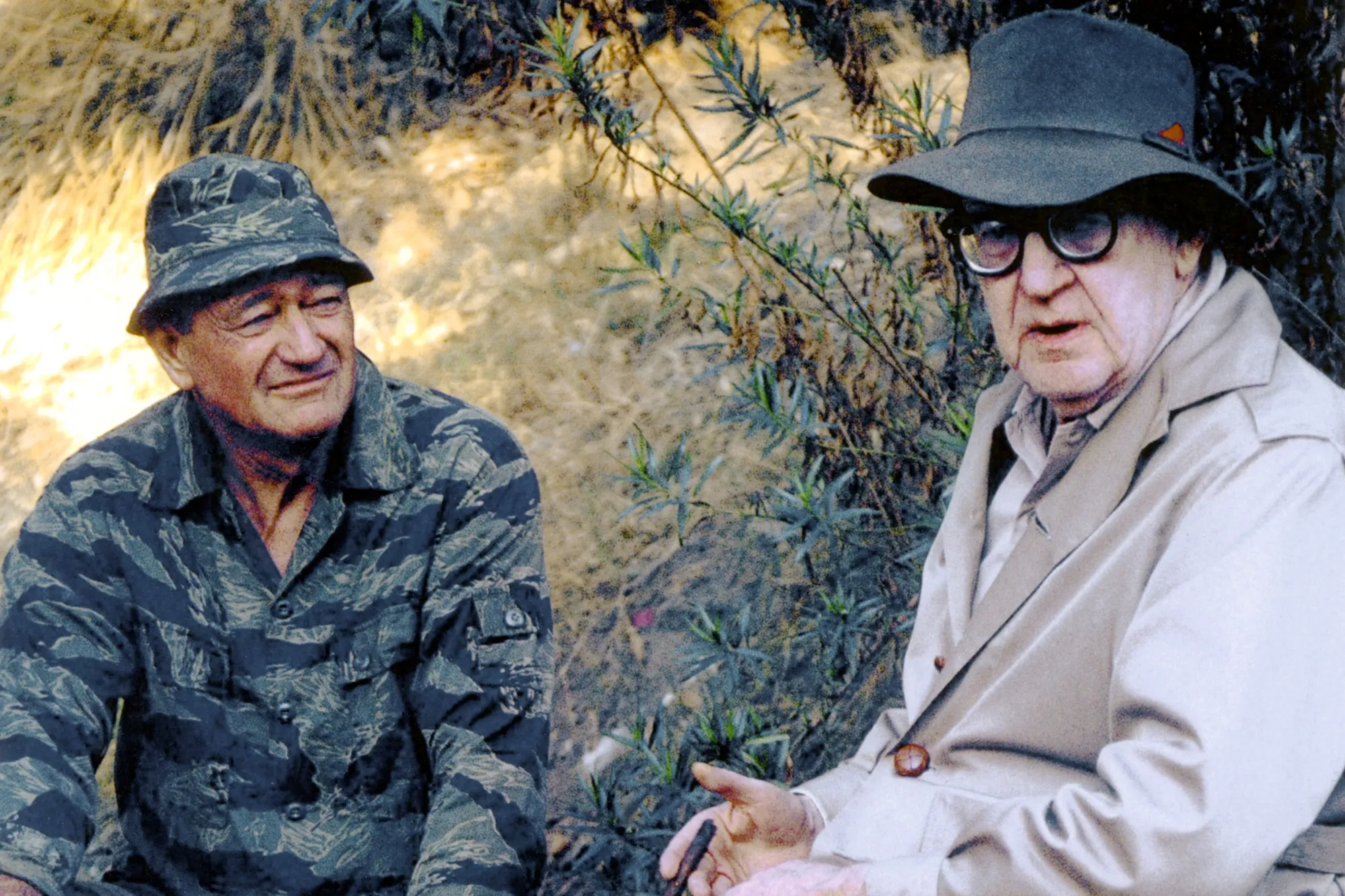Long, long ago John ford first noticed him in 1928, herding a flock of geese on the set of Mother Machree, an otherwise forgettable shanty-Irish weepie. The kid was huge, but innocent—or at least innocent-seeming. He had (he later claimed) “no desire” to be an actor. He was just a college football player earning spare cash as a property boy, an extra. Ford noticed him, but concluded that he wasn’t ready. (“I wanted some pain written on his face to offset the innocence.”) Looking at a still from 1930, you see immediately that Ford was right: He is soft and creamy, a “come-hither” carved out of a half-baked cheesecake. It was Raoul Walsh who finally cast him in his first lead role, in The Big Trail, released in 1930, and who told him, after consulting with the studio bosses, to change his name to John Wayne.
The Big Trail bombed—magnificently, on the scale of Cleopatra and Heaven’s Gate—and this sent Wayne back to Hollywood purgatory. He made dozens of Westerns for the so-called Poverty Row studios, disposable Saturday-matinee “oaters” for boys. (That Wayne endured making them for nearly a decade somewhat belies his claim of having no ambitions as an actor.) When Ford spotted him again, he was fishing off a pier in Long Beach, a B-level player whose confidence was shot. Ford didn’t care; he prized men for their mateyness. He invited Wayne onto his boat, the Araner, and after a while added him to his inner circle. One day in 1938, Ford—an Academy Award–winning director now—tossed his hanger-on a script and, calling him an “idiot,” offered him the lead in Stagecoach.

In the final tally, they made 23 pictures together. Three of them—Stagecoach (1939), The Searchers (1956), and The Man Who Shot Liberty Valance (1962)—are, by any standard, among the best and most important Hollywood films ever made. In their creative partnership, “the two men succeeded in defining an ideal of American masculinity that dominated for nearly half a century,” Nancy Schoenberger writes in Wayne and Ford: The Films, the Friendship, and the Forging of an American Hero. Schoenberger, an English professor at William & Mary, gamely argues that the masculine ideal, as championed by Ford and embodied by Wayne, is still salvageable, honorable even, and she cites her admiration for her own father, a test pilot. Stoic, humble, gallant, self-sufficient, loyal—put that way, who could disagree?
But that is not the whole story. Schoenberger has hidden a provocative thesis inside a Christmas present for Dad. She asks us to remember the beauty of masculine self-mastery as Ford presented it in his very best films. And yet, from the bulk of the evidence here, masculinity (like the Western) is a by-product of nostalgia, a maudlin elegy for something that never existed—or worse, a masquerade that allows no man, not even John Wayne, to be comfortable in his own skin.
In the long working friendship

In the long working “friendship” between the two men, unless I missed it, Ford never spared a kind word for his protégé. In fact, Ford was savage in his mistreatment of Wayne, even though—or because?—Wayne worshipped him. (“My whole set up was that he was my mentor and my ideal! I think that deep down inside, he’s one of the greatest human beings that I have ever known.”) From Stagecoach through Liberty Valance, their last Western together, Ford rode Wayne so mercilessly that fellow performers—remarkably, given the terror Ford inspired—stepped in on Wayne’s behalf. Filming Stagecoach, Wayne revealed his inexperience as a leading man, and this made Ford jumpy. “Why are you moving your mouth so much?” he demanded, grabbing Wayne by the chin. “Don’t you know that you don’t act with your mouth in pictures?” And he hated the way Wayne moved. “Can’t you walk, instead of skipping like a goddamn fairy?”
Masculinity, says Schoenberger, echoing Yeats, was for Ford a quarrel with himself out of which he made poetry. Jacques Lacan’s definition of love might be more apt: “Giving something you don’t have to someone who doesn’t want it.” Ford was terrified of his own feminine side, so he foisted a longed-for masculinity on Wayne. A much simpler creature than Ford, Wayne turned this into a cartoon, and then went further and politicized it. There was an awful pathos to their relationship—Wayne patterning himself on Ford, at the same time that Ford was turning Wayne into a paragon no man could live up to.
